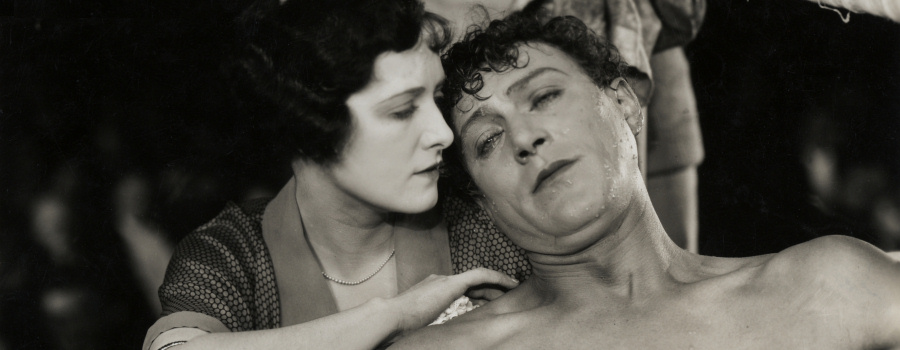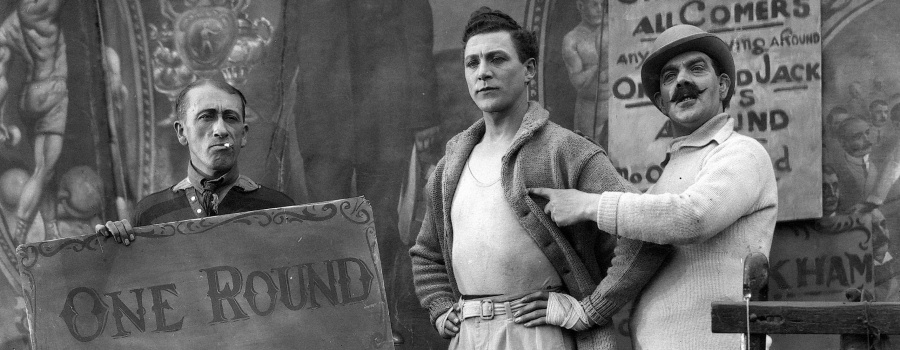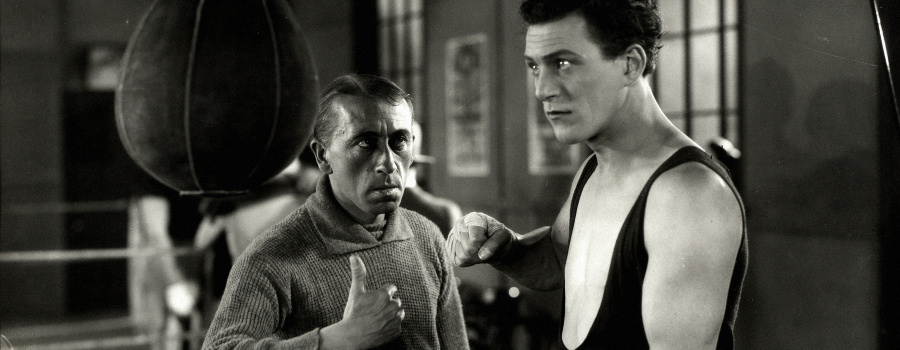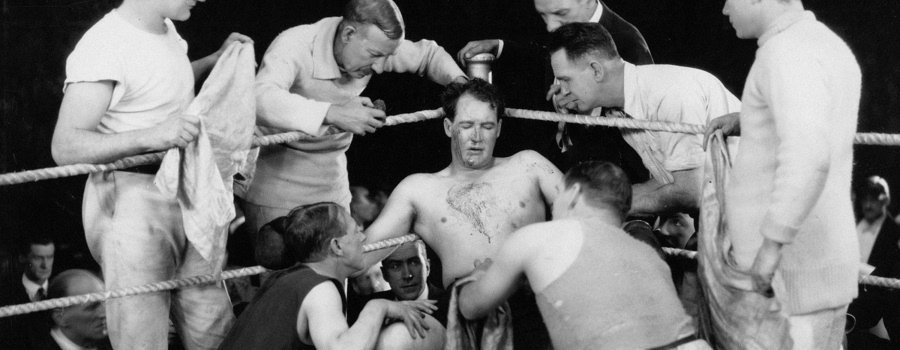The Ring (1927)
 | |
| Alfred Hitchcock | |
| John Maxwell | |
| Alfred Hitchcock | |
| Carl Brisson Lillian Hall-Davis Ian Hunter | |
| Jack E. Cox | |
| 94 minutes (8445 feet) | |
| black & white | |
| silent with English intertitles | |
| 1.33:1 | |
| British International Pictures | |
| Wardour Films (UK) | |
| DVD | |
Synopsis
"One Round" Jack is a boxer who fights in bazaars. He is engaged to Nelly. Without revealing his true identity, the Australian champion Bob Corby, who is falling in love with Nelly, challenges Jack. "One round" loses and Bob, who wants to be close to Nelly, hires Jack as his sparring partner. A short time passes until Bob and Nelly run away together. Jack is now in training for his revenge. He challenges Bob in the Albert Hall.
Production
Hitchcock had joined British International Pictures (BIP) in June 1927, shortly after completing Easy Virtue for Gainsborough — John Maxwell's offer of a higher salary (£13,000 per annum), more creative freedom and better studio facilities was enough to tempt the director away from Michael Balcon's studio.[1][2]
Pre-Production
Screenplay
As early as April 1927, Hitchcock had been talking about his idea for a film based around the boxing and a scenario was already complete prior to joining BIP.
Although Hitchcock is the sole named writer in the film's credits, there is evidence that both Eliot Stannard and Walter C. Mycroft were involved in the development of the scenario. [3][4]
Casting
According to Patrick McGilligan, Hitchcock had more control over casting than he had at Gainsborough and hand-picked Lillian Hall-Davis, Carl Brisson and Ian Hunter as the three leads, and Gordon Harker as the Brisson's trainer.[5]
Crew
Respected and experienced cameraman Jack Cox, an expert at "in camera" effects such as dissolves, overlays and double-exposures, was selected as cinematographer and would go on to work with Hitchcock on all of his BIP films.[6]
Principal Photography
Filming took place during July and August 1927.
With a larger budget than before, the fairground used in the opening section of the film was built on the lot at Elstree Studios and hundreds of extras were hired.[7]
The film's climax allowed Hitchcock to experiment with the Schüfftan process to seemingly stage the scene within the Royal Albert Hall.[8] Italian-born artist Fortunino Matania, who specialised in creating life-like crowd scenes, worked on the film.[9]
Release & Reception
With impressive speed, the film was edited in early September and previewed to the trade towards the end of the month.[10]
The Western Morning News hailed it as "the first of a new series of British films, and is a very complete answer to the pessimists who assert that no good films are made in England [...] Hitherto British film directors have too often imitated, with little success, the work of their American rivals, but Alfred Hitchcock has at last got right away from the beaten track."[11]
The Guardian review noted Hitchcock's "unusual resource and inventiveness in camera work, and a flair for the comic, pull him through easily, with a series of neat effects" and concluded by saying, "If British films as a whole can rise to this standard, the masterpieces will not be lacking, and, quota or no quota, the new industry will be firmly established".[12]
Similarly, The Times reported that the "opening scenes at a fair are remarkable for variety in photographic angle and for imaginative use of light" and that the "film as a whole marks a considerable technical advance".[13]
A special editorial in The Bioscope addressed Hitchcock directly:[14][15]
You have set the standard not only for your own company but for every British producer, and if future British films only approach "The Ring" in quality, we need have no fears for the ultimate success of the entire producing industry in this country.
Our first hope is that you will long continue to make films in this country, because the producing industry — which owes you a debt of gratitude — can ill afford to be without your talent.
With Jack Cox's skill with special effects and unusual camera setups, Hitchcock was able to create a surprisingly expressionistic British film which American film critic Jonathan Rosenbaum described as "the most Germanic in style of Hitchcock's silent films".[16]
Preservation Status
As part of the "Save the Hitchcock 9" campaign, started in 2010, the British Film Institute undertook a full restoration of The Ring. As part of their research, the BFI discovered that the only surviving negative (an export version from the French archives) is, in fact, mostly made up of alternative takes of each scene.[17] Instead, acetate duplicating positives of both The Ring and The Farmer's Wife from the 1960s are now the earliest-generation sources of the original films.[18]
See Also...
For further relevant information about this film, see also...
- 1000 Frames of The Ring (1927)
- Articles about The Ring (1927)
- Filming locations
- Titles and Intertitles
- Trivia
- Web links to information, articles, reviews, etc
DVD Releases
released in 2008

|
Le Masque de Cuir (1927) / À l'Américaine (1928) - Studio Canal (France, 2008) PAL 1.33:1 |
released in 2007

|
The Ring (1927) - Lionsgate (USA, 2007) NTSC 1.33:1 |

|
The Ring (1927) - Optimum Releasing (UK, 2007) PAL 1.33:1 |
Image Gallery
Images from the Hitchcock Gallery (click to view larger versions or search for all relevant images)...
Film Frames

Themes
Cast and Crew
Directed by:
- Alfred Hitchcock
- Frank Mills - assistant director
Starring:
- Carl Brisson - "One-Round" Jack Sander
- Lillian Hall-Davis - Mabel, The Girl
- Ian Hunter - Bob Corby
- Forrester Harvey - James Ware, Promoter
- Harry Terry - Showman
- Gordon Harker - Jack's Trainer
- Clare Greet - Fortune Teller (uncredited)
- Tom Helmore (uncredited)
- Minnie Rayner - Boxing Contestant's Wife (uncredited)
- Brandy Walker - Spectator (uncredited)
- Billy Wells - Boxer (uncredited)
Produced by:
Written by:
Photographed by:
Art Direction by:
Visual Effects by
- W Percy Day - matte painter (uncredited)
Notes & References
- ↑ Alfred Hitchcock: A Life in Darkness and Light (2003) by Patrick McGilligan, pages 94-95
- ↑ Alfred Hitchcock and the British Cinema (2000) by Tom Ryall, page 92
- ↑ Alfred Hitchcock: A Life in Darkness and Light (2003) by Patrick McGilligan, page 94
- ↑ Hitchcock was keen on attending sporting events, especially boxing, football, tennis and table tennis
- ↑ Alfred Hitchcock: A Life in Darkness and Light (2003) by Patrick McGilligan, page 95
- ↑ Alfred Hitchcock: A Life in Darkness and Light (2003) by Patrick McGilligan, pages 95-96
- ↑ Alfred Hitchcock: A Life in Darkness and Light (2003) by Patrick McGilligan, pages 96-97
- ↑ Alfred Hitchcock: A Life in Darkness and Light (2003) by Patrick McGilligan, page 97
- ↑ Yorkshire Post (23/Aug/1927) - Albert Hall Boxing Scenes
- ↑ Alfred Hitchcock: A Life in Darkness and Light (2003) by Patrick McGilligan, page 98
- ↑ Western Morning News (03/Oct/1927) - A New British Film
- ↑ The Guardian (09/Nov/1927) - The Ring: Mr. Carl Brisson in Films
- ↑ The Times (22/Nov/1927) - Entertainments
- ↑ Alfred Hitchcock: A Life in Darkness and Light (2003) by Patrick McGilligan, page 98
- ↑ Alfred Hitchcock and the British Cinema (2000) by Tom Ryall, page 93
- ↑ Alfred Hitchcock: A Life in Darkness and Light (2003) by Patrick McGilligan, page 97
- ↑ Standard Hollywood practice at the time was to use two side-by-side cameras to generate two near-identical negatives (one being for export). However, BIP seem to have constructed their export negatives using the unused alternative takes of each scene.
- ↑ Journal of Film Preservation (2012) - London - Restoring Hitchcock by Kieron Webb & Bryony Dixon
| Hitchcock's Major Films | |
| 1920s | The Pleasure Garden · The Mountain Eagle · The Lodger · Downhill · Easy Virtue · The Ring · The Farmer's Wife · Champagne · The Manxman · Blackmail |
| 1930s | Juno and the Paycock · Murder! · The Skin Game · Rich and Strange · Number Seventeen · Waltzes from Vienna · The Man Who Knew Too Much · The 39 Steps · Secret Agent · Sabotage · Young and Innocent · The Lady Vanishes · Jamaica Inn |
| 1940s | Rebecca · Foreign Correspondent · Mr and Mrs Smith · Suspicion · Saboteur · Shadow of a Doubt · Lifeboat · Spellbound · Notorious · The Paradine Case · Rope · Under Capricorn |
| 1950s | Stage Fright · Strangers on a Train · I Confess · Dial M for Murder · Rear Window · To Catch a Thief · The Trouble with Harry · The Man Who Knew Too Much · The Wrong Man · Vertigo · North by Northwest |
| 1960s | Psycho · The Birds · Marnie · Torn Curtain · Topaz |
| 1970s | Frenzy · Family Plot |
| view full filmography | |




